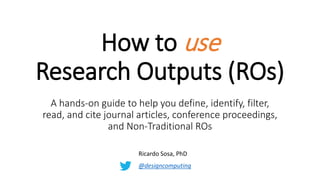
How to use "research outputs"
- 1. How to use Research Outputs (ROs) A hands-on guide to help you define, identify, filter, read, and cite journal articles, conference proceedings, and Non-Traditional ROs Ricardo Sosa, PhD @designcomputing
- 2. WhatareResearchOutputs(ROs)? ROs include traditional academic publications: journal articles, books and book chapters, conference proceedings, etc. It also includes non-traditional outputs (NTROs) such as visual essays, exegesis, ‘expositions’, insight papers, reflective papers, perspectives, essays, etc.
- 4. http://www.sankeymatic.com/build/ Database A [1000] Hits Database B [300] Hits Database C [1400] Hits Database D [200] Hits Hits [200] Select Hits [2700] Ignore Select [100] Skim Select [50] Read Select [50] Keep Skim [30] Redefine Skim [60] Delete Skim [10] References Read [10] Redefine Read [30] Delete Read [9] References Read [1] Cite ' After your Flows are entered, use the ' controls below to customize your ' diagram's appearance. ' For even finer control over presentation, ' see the Manual (linked above).
- 10. Step0:TypeofRO
- 11. Clue 0: Your results are heavily shaped by where you search Learn the (very) different catalogues that index Creative Technologies research
- 12. “pain” = 483,291 hits (JSTOR) “pain” = 1.3M (ScienceDirect) “pain” = 4M (Google Scholar)
- 13. Step1:Title pain
- 14. Step1:Title pain
- 16. Step1:Title
- 17. Clue 01: The title can indicate the onto-epistemology and methodology of the work Learn to identify terms and words that give away key information. You can use such terms to define/redefine/refine your search
- 18. “meaning of pain” = 5,980 hits “measurement of pain” = 25,400 hits
- 19. allintitle: pain experience allintitle: pain measurement
- 20. Step2:Author(s) Four authors, all from same department (Engineering) and two from industry One author, from Design department Two authors, from Education and from Psychology departments One author from Computer Science
- 21. Step2:Author(s)
- 22. Step2:Author(s)
- 23. Step2:Author(s)
- 24. Step2:Author(s)
- 25. Clue 02: The authors suggest the onto-epistemology and methodology of the work Learn to identify how authors’ affiliations give away key information
- 26. Step3:Abstract
- 27. Step3:Abstract
- 28. Step3:Abstract
- 29. Step3:Abstract
- 30. Step3:Abstract
- 31. Clue 03: A good abstract introduces the topic, justifies the study, hints at the methods, and shows the results and contribution Good abstracts are hard to find. Some ROs don’t have abstracts, the first paragraph should meet this function
- 32. Step4:Keywords Mobile Internet use Privacy Social Computing Domestic abuse Communities Digital dating abuse Intimate partner violence Technological intimate partner violence Technology Technological disinhibition
- 33. Step4:Keywords
- 34. Clue 04: Identify good keywords to (re)define search terms. Always keep an eye on keywords Learn to identify good keywords and new keywords that you may have missed before. Keep a list at hand
- 36. Step5:Keysection(s) Pacanowsky, M. (1995). Team tools for wicked problems. Organizational Dynamics, 23(3), 36-51. https://doi.org/10.1016/0090-2616(95)90024-1 Similar papers? What would you look at to decide if you should read it?
- 39. Step5:Keysection(s) Read #1 if you need an overall idea of the field and this work Read #2 when you need to scope the background or check your familiarity Read #3 to understand what and how this person did in detail Read #4 to see the results and #5 for claims and implications Read #6 for open questions and References to scope the background
- 40. Clue 05: What should you read first? Learn to decide how you should skim/read an RO depending on what you are looking for. Only very few papers you need to read entirely from beginning to end
- 41. Step6:References Sources: • Conferences: CoDesigning, CHI, INTERACT, Journals: • Design Studies, Product Innovation Management, Consumer Research, Design Issues Book publishers: • New Riders, Penguin, Routledge, Van Nostrand R, Methuen, Carcanet, Basic Books Years: • 1960s, 1970s, 1980s, 1990s, 2000s
- 42. Step6:References
- 43. Step6:References
- 44. Step6:References
- 45. Step6:References
- 46. Clue 06: References help readers ‘locate’ the work Learn that ROs across disciplines follow *very* different conventions. Scan the references, notes, or bibliography to get a better idea of the background and related works
- 55. Clue 07: The methods or study design section (usually the third) should explicitly say how the work was carried out Learn to identify the *very* different ways in which authors describe what and how they did
- 60. Clue 08: The results and claims section (usually second-last) is where the contribution of this work is made: findings, analysis, implications, demonstrations Learn to quickly locate the ‘substance’ of an RO and to assess it based on all the other sections. Watch out for unsubstantiated claims and flaws
- 61. Step9:Discussion
- 62. Step9:Discussion
- 63. Step9:Discussion
- 64. Step9:Discussion
- 65. Clue 09: The last section usually summarises the work (so it’s good to read it first), takes a broad view of the results, and frames new questions Learn when to start reading an RO from the end as a way to assess whether you should bother reading the rest
- 68. Clue 10: Use the RO to keep navigating the field. Locate the key references and ROs that cite this work Learn to identify a few (key) references to check next, look at ‘Cited by’ works, set up alerts, look for the author/journal/conference for further related ROs
